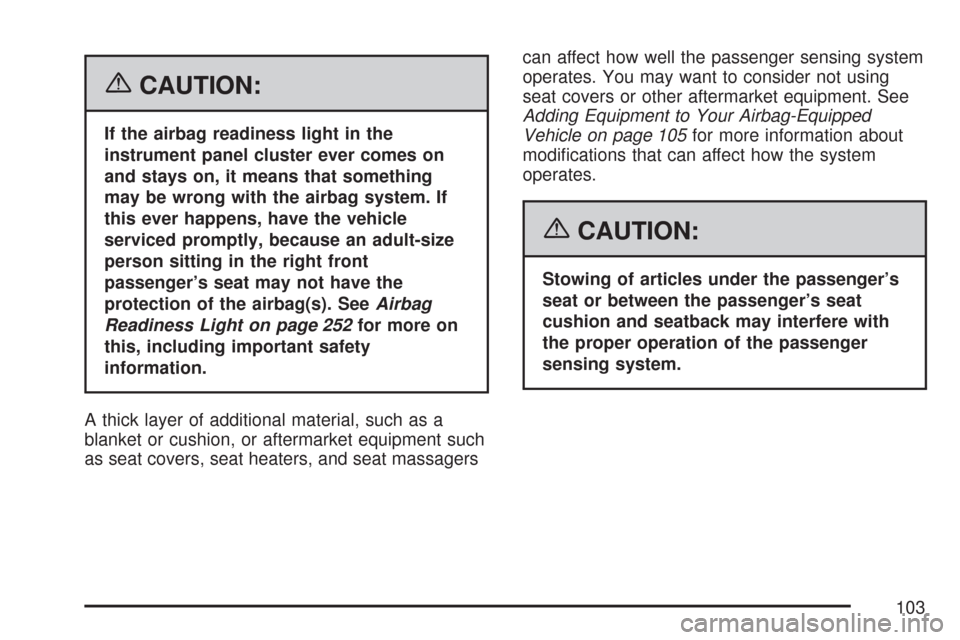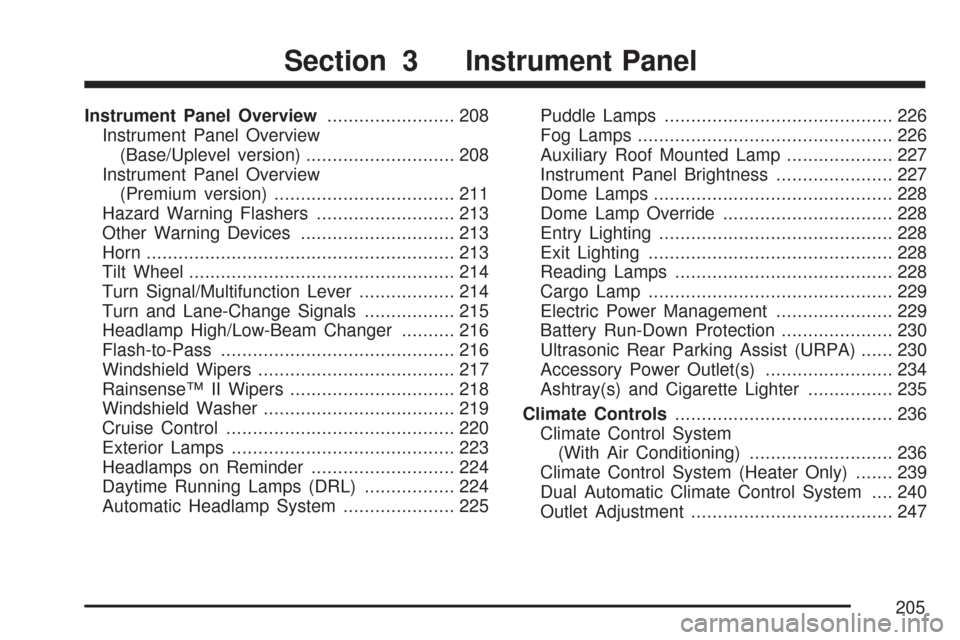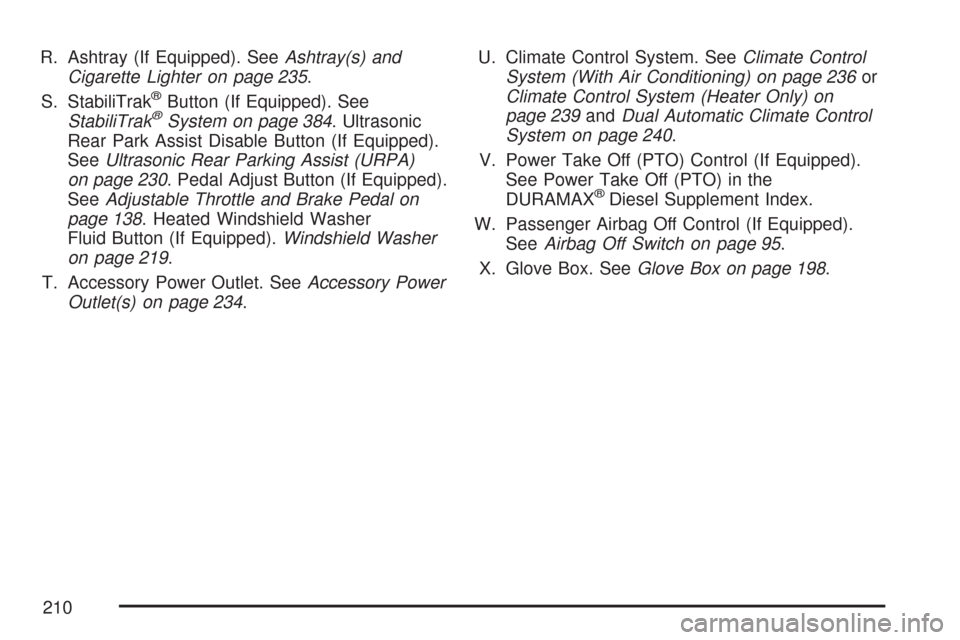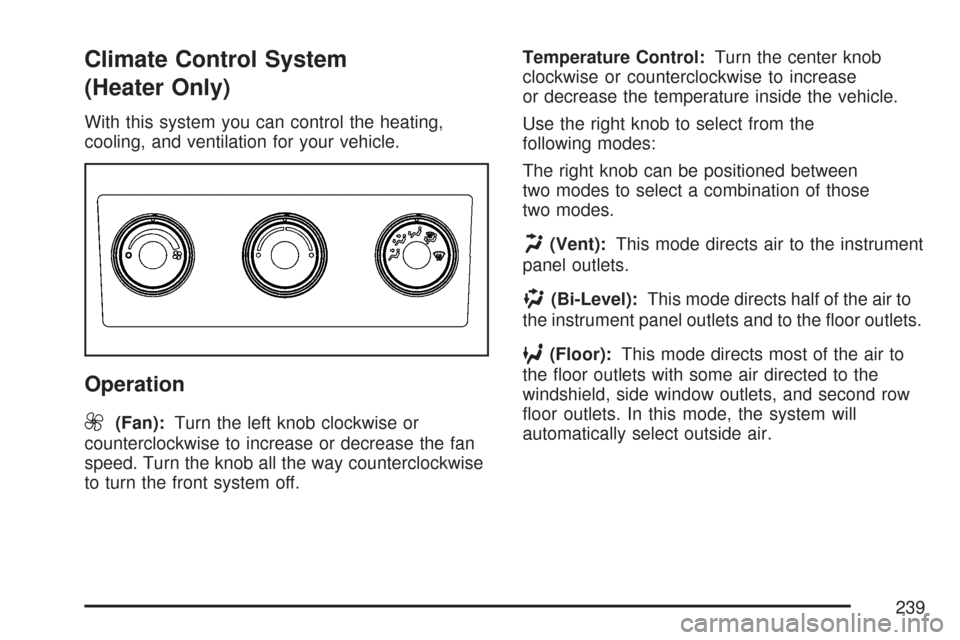2007 CHEVROLET SILVERADO heater
[x] Cancel search: heaterPage 103 of 684

{CAUTION:
If the airbag readiness light in the
instrument panel cluster ever comes on
and stays on, it means that something
may be wrong with the airbag system. If
this ever happens, have the vehicle
serviced promptly, because an adult-size
person sitting in the right front
passenger’s seat may not have the
protection of the airbag(s). SeeAirbag
Readiness Light on page 252for more on
this, including important safety
information.
A thick layer of additional material, such as a
blanket or cushion, or aftermarket equipment such
as seat covers, seat heaters, and seat massagerscan affect how well the passenger sensing system
operates. You may want to consider not using
seat covers or other aftermarket equipment. See
Adding Equipment to Your Airbag-Equipped
Vehicle on page 105for more information about
modi�cations that can affect how the system
operates.
{CAUTION:
Stowing of articles under the passenger’s
seat or between the passenger’s seat
cushion and seatback may interfere with
the proper operation of the passenger
sensing system.
103
Page 109 of 684

Keys............................................................ 111
Remote Keyless Entry (RKE) System........ 112
Remote Keyless Entry (RKE) System
Operation............................................... 113
Doors and Locks........................................ 120
Door Locks................................................ 120
Power Door Locks..................................... 121
Delayed Locking........................................ 121
Programmable Automatic Door Locks........ 121
Rear Door Security Locks......................... 122
Lockout Protection..................................... 122
Rear Doors............................................... 123
Tailgate..................................................... 124
Windows...................................................... 126
Manual Windows....................................... 126
Power Windows........................................ 127
Power Sliding Rear Window...................... 128
Sun Visors................................................ 129
Theft-Deterrent Systems............................. 129
Content Theft-Deterrent............................. 130
PASS-Key
®III+......................................... 131
PASS-Key®III+ Operation......................... 132Starting and Operating Your Vehicle......... 134
New Vehicle Break-In................................ 134
Ignition Positions....................................... 135
Retained Accessory Power (RAP)............. 136
Starting the Engine.................................... 136
Adjustable Throttle and Brake Pedal.......... 138
Engine Coolant Heater.............................. 138
Active Fuel Management™........................ 140
Automatic Transmission Operation............. 140
Tow/Haul Mode......................................... 146
Four-Wheel Drive...................................... 149
Parking Brake........................................... 164
Shifting Into Park (P)................................. 165
Shifting Out of Park (P)............................. 167
Parking Over Things That Burn................. 168
Engine Exhaust......................................... 169
Running the Engine While Parked............. 170
Mirrors......................................................... 171
Manual Rearview Mirror............................. 171
Automatic Dimming Rearview Mirror with
OnStar
®, Compass and Temperature
Display................................................... 171
Section 2 Features and Controls
109
Page 138 of 684

Adjustable Throttle and Brake Pedal
If your vehicle has this feature, you can change
the position of the throttle and brake pedals.
This feature is designed for shorter drivers, since
the pedals cannot move farther away from the
standard position, but can move toward the driver
for better pedal reach.
The switch used to
adjust the pedals is
located on the
instrument panel below
the climate control
system.
Press the arrow at the bottom of the switch to
move the pedals closer to your body. Press
the arrow at the top of the switch to move the
pedals away from your body.Before you start driving, fully press the brake
pedal to con�rm the adjustment is right for you.
While driving, make only small adjustments.
No adjustment to the pedals can be made when
the vehicle is in REVERSE (R) or while using
the cruise control.
Your vehicle may have a memory function which
allows pedal settings to be saved and recalled.
SeeMemory Seat, Mirrors, and Pedals on page 13
for more information.
Engine Coolant Heater
Your vehicle may have an engine coolant heater.
If your vehicle has the DURAMAX
®Diesel
engine, see the DURAMAX®Diesel manual for
more information.
In very cold weather, 0°F (−18°C) or colder, the
engine coolant heater can help. You will get easier
starting and better fuel economy during engine
warm-up.
138
Page 139 of 684

Usually, the coolant heater should be plugged in a
minimum of four hours prior to starting your
vehicle. At temperatures above 32°F (0°C), use of
the coolant heater is not required. Your vehicle
may also have an internal thermostat in the
plug end of the cord. This will prevent operation of
the engine coolant heater when the temperature
is at or above 0°F (−18°C) as noted on the cord.
To Use the Engine Coolant Heater
1. Turn off the engine.
2. Open the hood and unwrap the electrical
cord. The cord is located on the driver’s
side of the engine compartment, near
the power steering �uid reservoir.
3. Plug the cord into a normal, grounded
110-volt AC outlet.
{CAUTION:
Plugging the cord into an ungrounded
outlet could cause an electrical shock.
Also, the wrong kind of extension cord
could overheat and cause a �re. You
could be seriously injured. Plug the cord
into a properly grounded three-prong
110-volt AC outlet. If the cord will not
reach, use a heavy-duty three-prong
extension cord rated for at least 15 amps.
4. Before starting the engine, be sure to unplug
and store the cord as it was before to keep it
away from moving engine parts. If you do not, it
could be damaged.
How long should you keep the coolant heater
plugged in? The answer depends on the outside
temperature, the kind of oil you have, and some
other things. Instead of trying to list everything here,
we ask that you contact your dealer in the area
where you will be parking your vehicle. The dealer
can give you the best advice for that particular area.
139
Page 205 of 684

Instrument Panel Overview........................ 208
Instrument Panel Overview
(Base/Uplevel version)............................ 208
Instrument Panel Overview
(Premium version).................................. 211
Hazard Warning Flashers.......................... 213
Other Warning Devices............................. 213
Horn.......................................................... 213
Tilt Wheel.................................................. 214
Turn Signal/Multifunction Lever.................. 214
Turn and Lane-Change Signals................. 215
Headlamp High/Low-Beam Changer.......... 216
Flash-to-Pass............................................ 216
Windshield Wipers..................................... 217
Rainsense™ II Wipers............................... 218
Windshield Washer.................................... 219
Cruise Control........................................... 220
Exterior Lamps.......................................... 223
Headlamps on Reminder........................... 224
Daytime Running Lamps (DRL)................. 224
Automatic Headlamp System..................... 225Puddle Lamps........................................... 226
Fog Lamps................................................ 226
Auxiliary Roof Mounted Lamp.................... 227
Instrument Panel Brightness...................... 227
Dome Lamps............................................. 228
Dome Lamp Override................................ 228
Entry Lighting............................................ 228
Exit Lighting.............................................. 228
Reading Lamps......................................... 228
Cargo Lamp.............................................. 229
Electric Power Management...................... 229
Battery Run-Down Protection..................... 230
Ultrasonic Rear Parking Assist (URPA)...... 230
Accessory Power Outlet(s)........................ 234
Ashtray(s) and Cigarette Lighter................ 235
Climate Controls......................................... 236
Climate Control System
(With Air Conditioning)........................... 236
Climate Control System (Heater Only)....... 239
Dual Automatic Climate Control System.... 240
Outlet Adjustment...................................... 247
Section 3 Instrument Panel
205
Page 210 of 684

R. Ashtray (If Equipped). SeeAshtray(s) and
Cigarette Lighter on page 235.
S. StabiliTrak
®Button (If Equipped). See
StabiliTrak®System on page 384. Ultrasonic
Rear Park Assist Disable Button (If Equipped).
SeeUltrasonic Rear Parking Assist (URPA)
on page 230. Pedal Adjust Button (If Equipped).
SeeAdjustable Throttle and Brake Pedal on
page 138. Heated Windshield Washer
Fluid Button (If Equipped).Windshield Washer
on page 219.
T. Accessory Power Outlet. SeeAccessory Power
Outlet(s) on page 234.U. Climate Control System. SeeClimate Control
System (With Air Conditioning) on page 236or
Climate Control System (Heater Only) on
page 239andDual Automatic Climate Control
System on page 240.
V. Power Take Off (PTO) Control (If Equipped).
See Power Take Off (PTO) in the
DURAMAX
®Diesel Supplement Index.
W. Passenger Airbag Off Control (If Equipped).
SeeAirbag Off Switch on page 95.
X. Glove Box. SeeGlove Box on page 198.
210
Page 212 of 684

E. Shift Lever. SeeAutomatic Transmission
Operation on page 140.
F. Tow/Haul Selector Button (If Equipped). See
Tow/Haul Mode on page 146.
G. Driver Information Center (DIC) Controls. See
Driver Information Center (DIC) on page 269.
H. Audio System. SeeAudio System(s) on
page 302.
I. Exterior Lamps Control. SeeExterior Lamps on
page 223.
J. Integrated Trailer Brake Controller (If
Equipped). SeeTowing a Trailer on page 447.
K. Dome Lamp Override Button. SeeDome
Lamp Override on page 228. Dome Lamp
Knob. SeeDome Lamps on page 228.
L. Automatic Transfer Case Control. (If Equipped).
SeeFour-Wheel Drive on page 149.
M. Hood Release. SeeHood Release on
page 498.
N. Parking Brake. SeeParking Brake on
page 164.
O. Cruise Control Buttons. SeeCruise Control on
page 220.
P. Tilt Wheel Lever. SeeTilt Wheel on page 214.Q. Horn. SeeHorn on page 213.
R. Audio Steering Wheel Controls. SeeAudio
Steering Wheel Controls on page 370.
S. Climate Controls. SeeClimate Control System
(With Air Conditioning ) on page 236or
Climate Control System (Heater Only) on
page 239or Dual Automatic Climate Controls
(If Equipped). SeeDual Automatic Climate
Control System on page 240.
T. Accessory Power Outlets. SeeAccessory
Power Outlet(s) on page 234. Cigarette Lighter
(If Equipped). SeeAshtray(s) and Cigarette
Lighter on page 235.
U. StabiliTrak
®Button (If Equipped). See
StabiliTrak®System on page 384. Pedal Adjust
Button (If Equipped). SeeAdjustable Throttle
and Brake Pedal on page 138. Rear Park Assist
Disable Button (If Equipped). SeeUltrasonic
Rear Parking Assist (URPA) on page 230.
Heated Windshield Washer Fluid Button
(If Equipped). SeeWindshield Washer on
page 219.
V. Passenger Airbag Off Control (If Equipped).
SeeAirbag Off Switch on page 95.
W. Glove Box. SeeGlove Box on page 198.
212
Page 239 of 684

Climate Control System
(Heater Only)
With this system you can control the heating,
cooling, and ventilation for your vehicle.
Operation
9
(Fan):Turn the left knob clockwise or
counterclockwise to increase or decrease the fan
speed. Turn the knob all the way counterclockwise
to turn the front system off.Temperature Control:Turn the center knob
clockwise or counterclockwise to increase
or decrease the temperature inside the vehicle.
Use the right knob to select from the
following modes:
The right knob can be positioned between
two modes to select a combination of those
two modes.
H(Vent):This mode directs air to the instrument
panel outlets.
)(Bi-Level):This mode directs half of the air to
the instrument panel outlets and to the �oor outlets.
6(Floor):This mode directs most of the air to
the �oor outlets with some air directed to the
windshield, side window outlets, and second row
�oor outlets. In this mode, the system will
automatically select outside air.
239